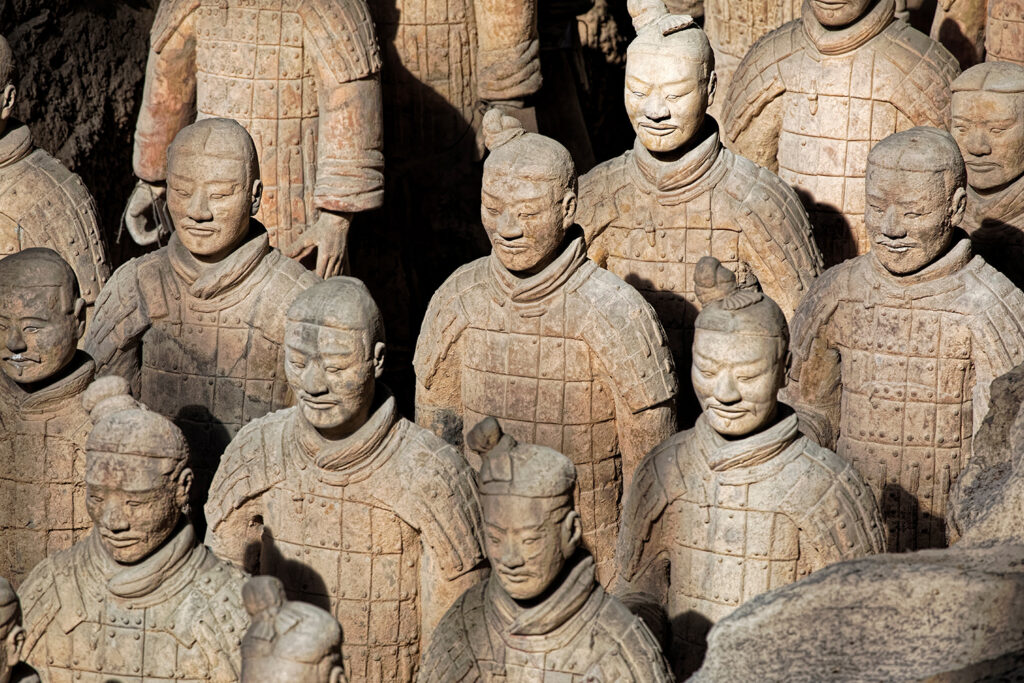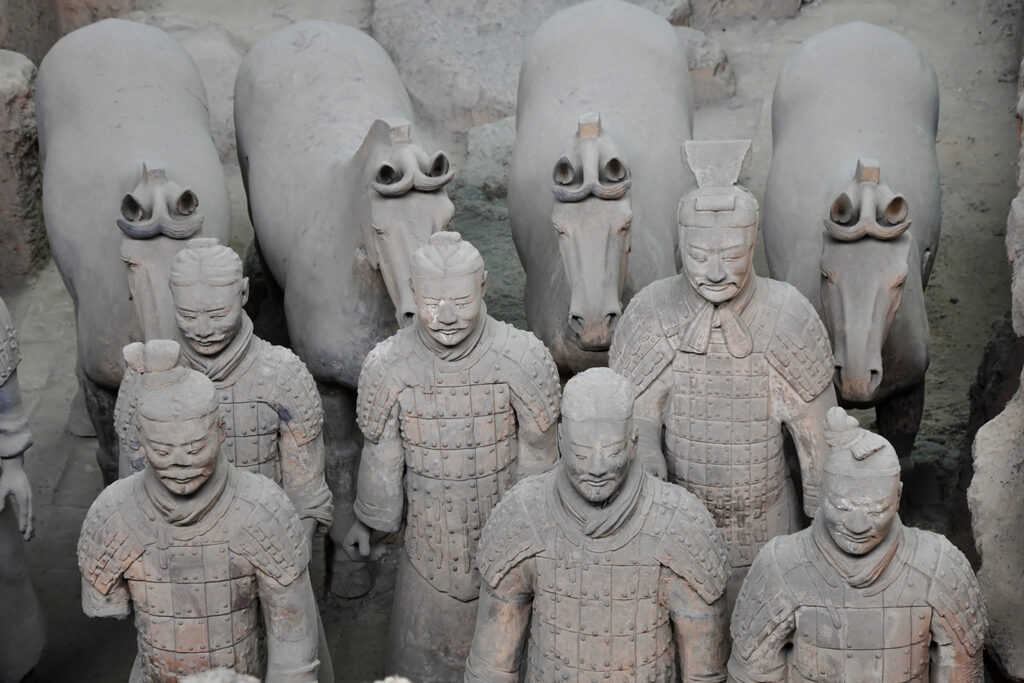Those who call this discovery the eighth wonder of the world have plenty of reasons to do so. After all, we’re talking about a clay army of thousands of completely distinct figures, guarding the tomb of a Chinese emperor who dreamed of eternal life.
The Terracotta Army, displayed 37 km east of Xi’an, in China’s Shaanxi province, is the main attraction drawing tourists from around the globe to this city. The discovery of this rather extensive collection of statues caused a huge sensation worldwide, not just among archaeologists or scholars of Chinese culture. After all, this collection of thousands of terracotta warriors guarding the first emperor of China remained underground for more than 2,000 years.
The greatest discovery of modern times
It was 1974 when, faced with a severe drought, the villagers of Xiyang decided to dig a well in a nearby forest. However, they did not expect to find fragments of broken terracotta figures and bronze weapons beneath the ground. This led to the immediate halt of any well-digging activities and the authorities were notified. Thanks to them, archaeological excavations began later that same year, and experts concluded that the discovered artifacts were indeed related to the Qin dynasty of China.

The first excavated pit was named Pit 1. It is the largest of the four discovered pits, measuring 230 meters in length and 62 meters in width. This pit housed the main army, consisting of over 3,000 figures. Just two years after the excavation, the State Council decided to create an exhibition hall at the site. It was during these construction works that the pit now known as Pit 2, representing the military guard, began to emerge, followed shortly by Pit 3, which resembled a command post. Further excavations led to the discovery of a fourth pit, although this one, unfortunately, was found completely empty.
In 1979, the Museum of the Terracotta Warriors and Horses was opened, becoming the biggest attraction in the city of Xi’an and initially drawing thousands, then millions, of curious travelers from around the world. The entire mausoleum of the emperor, including the collection of terracotta warriors and horses, was listed as a UNESCO World Heritage Site on December 7, 1987.
Why was the terracotta army built?
So, why was such a massive army originally buried underground? The terracotta collection, now often referred to as the eighth wonder of the world, is the legacy of China’s first emperor, Qin Shi Huang. He is a figure who left a significant mark on the history of the country. Although he can certainly be described as a despot, there is no denying his immense contributions to China’s development. He not only standardized the writing system and currency, but most importantly, he unified China by subjugating the seven warring states that existed in what is now China. Some also claim that he initiated the construction of the Great Wall of China, now beloved by tourists. However, for this story, other details of his life are more relevant.
Sources report that Emperor Qin Shi ascended the throne as a teenager, and since he had dreamed of immortality from a young age, he immediately ordered the construction of his own mausoleum. The entire project involved around 700,000 workers from all Chinese provinces. Their task was not merely to create a simple tomb but to build an entire underground city designed to serve the emperor during his afterlife. Qin Shi believed that surrounding himself with treasures and weapons alone was not enough; during his afterlife, he would also need protection from an army of loyal warriors.

After the emperor’s death, all his valuables, personal items, and the Terracotta Army were placed in specially prepared underground chambers and meticulously buried to ensure that none of his possessions would fall into the wrong hands. Sources suggest that the first emperor of China died unexpectedly, and his tomb was not fully completed. It’s hard to imagine how the site, which already evokes such amazement today, might have appeared if this ambitious project had been fully realized.
Terracotta Army Museum
The Terracotta Army Museum covers an area of 16,300 square meters and is divided into three sections corresponding to the three excavation pits, numbered in the order of their discovery. Although Pit 1 is the most impressive in size, each of the pits has something remarkable to offer. Pit 2, for example, boasts the greatest variety of figures. Few people know that the original warrior figures were vividly colored, but unfortunately, most of these colors have faded over time. Pit 3, though the smallest of the three, is the only one that still displays figures with traces of their original color.
Inside the aforementioned exhibition chambers, there are more than 8,000 terracotta warriors arranged in battle formation. Most of them likely once carried real bronze weapons, although these are no longer visible today. Surprisingly, the army is not composed of identical copies of the same figure. In fact, it’s said that no two soldiers are exactly alike. Each figure is equipped with unique facial features, hairstyles indicating their status, and specific facial hair. The soldiers display a variety of gestures and hand positions and wear different uniforms, armor, or protective gear. Additionally, both the human figures and the horses are rendered in life-size proportions.
Who and what makes up the Terracotta Army?

Don’t be fooled by appearances. Upon entering the Terracotta Army Museum, you’ll experience much more than just rows of stone-clad, somber warriors. The figures were not only given individual features but also placed in a variety of poses. Their facial expressions capture movement, giving visitors the impression that the terracotta figures might spring to life at any moment. This lifelike quality extends beyond the battle-ready soldiers, as among the figures are civilian characters, reflecting the complex social structure of the Qin dynasty.
The Terracotta Army of Loyal Warriors
Of course, the ready-for-battle warriors make up the core of the first emperor’s army. Even within this group, you can distinguish between different types of soldiers. There are infantrymen standing guard alongside mid-ranking officers, who can be identified by their distinctive flat hats. Next to life-sized horses, you can observe cavalrymen dressed in special armor designed for horseback riding, poised to charge into battle.
Archers also stand ready to repel any attack. The standing archers appear to aim downward, while the kneeling ones aim upward, creating a complete archery formation within the army. The highest-ranking figures, of which nine have been found so far, are regarded as the most important. These officers can be recognized by their height and the special clothing and headgear that signify their elevated status. Additionally, special chariots with drivers were meant to serve the emperor in the afterlife.
Acrobats and officials
Proof that Qin Shi Huang intended to recreate his entire imperial court in the afterlife lies in the discovery of figures that weren’t designed to defend him. Excavations have revealed representations of officials and civil servants, unarmed but equipped with special knives used for writing notes on bamboo slips. Also found were acrobats dressed in short skirts resembling modern-day mini skirts. Their role was not only to entertain the emperor but also to immortalize the grandeur of the Qin dynasty’s acrobatic arts.
Weapons and other artifacts

Although much of the bronze weaponry is no longer present in the museum, several items from this category have survived. Excavations uncovered arrowheads, a few examples of long weapons, spears, daggers, and 24 swords, though some of the swords were broken. Beyond the weapons, one of the pits revealed over 80 pieces of armor and 40 helmets made from stone plates linked together by bronze wires.
Shields, quivers, musical instruments, and inscribed tablets have also withstood the test of time. One of the largest and heaviest artifacts discovered is a three-legged cauldron, likely used for cooking meat. Qin Shi Huang’s afterlife was to be accompanied not only by horses but also by animals like swans and cranes, with twenty bronze sculptures of swans and several cranes found in various poses.
The Mausoleum of Emperor Qin Shi Huang
The Museum of the Terracotta Army is actually part of the larger Museum of the Mausoleum of Emperor Qin Shi Huang. The terracotta warriors were meant to guard something even grander—Qin Shi Huang’s tomb, located about 1.5 km west of the Terracotta Army exhibit. The entire mausoleum was designed to replicate the layout of Xianyang, the capital of the Qin dynasty. For this reason, the necropolis is divided into an outer city and an inner city, where the emperor’s burial site is located.
Unfortunately, excavations are still ongoing, and the actual tomb of the emperor, which likely contains his remains and greatest treasures, has never been opened. Researchers are concerned not only about potential damage to the tomb but also about ancient warnings. According to Chinese texts, those who attempt to disturb the emperor’s final rest may face deadly traps. Another threat is the high levels of toxic mercury detected near the tomb. These risks have led archaeologists to delay opening the chamber until technology advances enough to handle these dangers.
Experts believe that this area once featured several buildings, though, unfortunately, none remain today. A memorial plaque honoring the emperor and the sprawling Lishan Park within the mausoleum grounds now pay tribute to him. Despite the absence of historical structures, this location is worth a brief stop, especially since entry to the park is covered by the same ticket used for the Museum of the Terracotta Army. Additionally, a free shuttle bus operates periodically between Lishan Garden and the museum.
How to get to the museum?
The best way to reach the mausoleum is by starting from the town of Xi’an. From there, you can easily find transportation options such as the metro, a tourist bus, or a taxi to take you to the Museum of the Terracotta Army. If you’re planning to visit during peak season, it’s advisable to purchase your tickets in advance to avoid long lines at the ticket office. For those who prefer the convenience of a fully organized trip without worrying about transport from Xi’an or ticket reservations, you can take advantage of numerous offers available on GetYourGuide. There, you can book entry tickets, access to audio guides, or tours with professional guides.
Practical information
- It is best to purchase tickets for the Terracotta Army Museum in advance. This way, you can avoid standing in long lines and reduce the risk of tickets being sold out.
- Address: Lintong District, Xi’An, Shaanxi, China, 710612
- Buy tickets on GetYourGuide